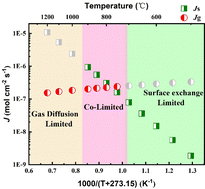Perspective on high-temperature surface oxygen exchange in a porous mixed ionic-electronic conductor for solid oxide cells†
Abstract
The surface exchange coefficient (k) of porous mixed ionic-electronic conductors (MIECs) determines the device-level electrochemical performance of solid oxide cells. However, a great difference is reported for k values, which are measured using presently available technologies of electrical conductivity relaxation (ECR), electrochemical impedance spectroscopy (EIS), and oxygen isotope exchange (OIE). In terms of this issue, this perspective paper estimates the possible physiochemical processes for the oxygen reduction reaction (ORR) in porous MIECs by comparing the oxygen supply/consumption fluxes through calculation. Then, the potential problems associated with ECR, EIS, and OIE for application in porous materials are discussed regarding theory, assumptions, sample requirements, and data processing. Finally, gas diffusion effects are revealed by comparing the simulated and measured ECR profiles, which show that the ORR process can be significantly delayed by gas diffusion. This perspective aims to recommend a reasonable method to characterize the true ORR kinetics of porous electrodes and quantify the effect of gas diffusion.

- This article is part of the themed collections: 2023 PCCP HOT Articles and 2023 PCCP Reviews


 Please wait while we load your content...
Please wait while we load your content...